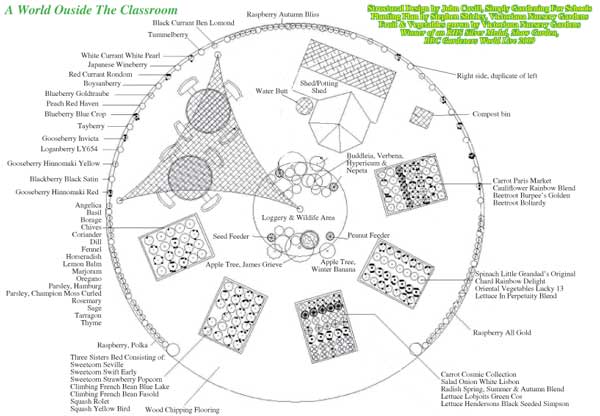A World Outside The Classroom

 We have long been at the forefront of encouraging children to garden - be it at home or in school - so when we received an email in late January 2009 asking us if we would be interested in growing the fruit and vegetables for a show garden, on a school gardening theme, to be displayed at BBC Gardeners' World Live later that year we were naturally very interested. Little did we know the journey this project would take us on or that it would lead to us winning both a much coveted RHS Silver Medal and being voted Favourite Show Garden in the BBC Gardeners' World People's Vote.
We have long been at the forefront of encouraging children to garden - be it at home or in school - so when we received an email in late January 2009 asking us if we would be interested in growing the fruit and vegetables for a show garden, on a school gardening theme, to be displayed at BBC Gardeners' World Live later that year we were naturally very interested. Little did we know the journey this project would take us on or that it would lead to us winning both a much coveted RHS Silver Medal and being voted Favourite Show Garden in the BBC Gardeners' World People's Vote.
Designed to show how a school kitchen and wildlife garden could be created on a limited budget, the garden has proved to be an inspiration for schools, teachers, children and their parents; at the show we were overwhelmed by such positive comments as, "this is the most inspirational garden I have ever seen", or "I saw the garden on the television and just had to come and see it for myself and talk to you about starting a garden club at my school".
For those who would like to replicate the garden (or even just pinch an idea or two), the design and plant list can be downloaded here - Design & Plant List.


On 20th January 2009 we received an email from John Cavill of Simply Gardening For Schools. John explained that many years ago when he lived in Kent he had been a customer and, knowing of the work we did with schools and School Gardening Clubs, wondered if we would be interested in growing the fruit and vegetable plants for a show garden on a Children's School Garden Theme he had designed for BBC Gardeners World Live. Of course we were curious and so we got in contact.
It emerged that John was a successful landscape gardener and garden designer based in Lincolnshire. He and his company, Simply Gardening, shared our ethos that children should be encouraged to grow their own produce and in the autumn of 2008 had set up a social enterprise company - Simply Gardening For Schools Ltd - to promote his campaign for school gardening and work with schools. It seemed so logical to work together on the project and so, after a staff vote (because of all the extra work it would involve) we agreed - and John and Stephen got down to business !
John had already produced a structural design and planting plan, but recognised there was room for improvement on the planting side and so asked Stephen for his thoughts. In under a week Stephen had completely redesigned the planting scheme, choosing plants more suited for schools and children (either because of cropping time or colour interest). Possibly the most radical design change was replacing the originally planned lavender hedge with a mixed planting of soft fruit which Stephen promptly called 'The Incredible Edible Fence'. As soon as the plan was redrawn with Stephen's amendments it was obvious that between John and Stephen they had come up with something very special and, in recognition of Stephen's efforts, John invited Victoriana to be detailed as co-designers of the garden.
Herewith the plan of the garden as built. This and a plant list can be downloaded from here - Design & Plant List. With the design finalised, John sat back and relaxed whilst we got on with the hard work of growing all the plants!
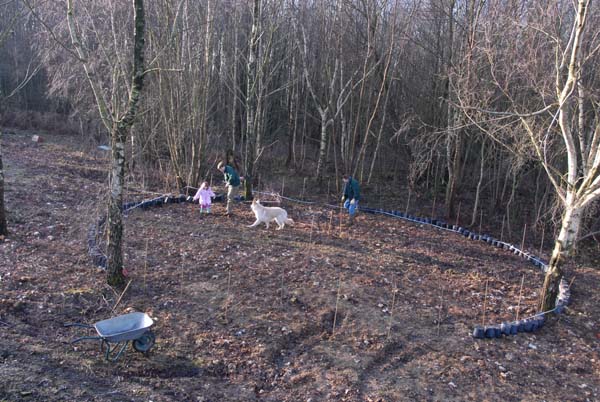
On 27th January - a week after we had received John's email - we roughly marked out the garden with bamboo canes and physically put empty pots in the places the plants were to be; here you can see Stephen, Mark and Milly - helped by Polar, of course. This gave us accurate figures for the number of plants required.

Two days later Mark and Brian started potting up the fruits. Everything used simply came from stock - the very plants we were lifting and selling at the time - as we thought it important that people would be able to see what could be achieved in just one growing season. The finished garden needed to look good, but it also needed reflect reality.

Due to other work pressures it wasn't until 14th February that all the fruit was finally potted and stood out in an unheated greenhouse which would help bring things on a little quicker.

With the fruit underway it was now time to turn our attentions to the vegetables. Milly and Grandad made the first sowings on 26th February. Little did we know that the RHS would later recognise her efforts and give her her own RHS medal with HER name on it!

By 29th March the vegetable seedlings were well advanced and potting-up commenced.

At the same time herb plants (once again from our normal stocks) were potted up.

And by 7th April all the longer term crops were potted and stood down pot thick.

All that remained now was to keep everything watered and clean of pests and diseases. We only had one surprise, when the aphids came earlier than anticipated - but these were quickly dispatched with our BioFriend Plant Defence, and weekly sprayings from the n on kept everything else at bay.

Later, the leaf crops were direct sown into pots, and similarly the radish and onions. As these crops could so easily go past their best, and we had no idea of the weather ahead, succesional sowings were made every few weeks; of course, the 'waste' plants went to good use and were eaten !

And then on 4th June John came down with an articulated lorry to collect everything. We were pleased to see it go - not least because by then the spaced-out plants were taking up a massive 3000 square feet of protected space ! And of course we were all able to relax for a day or so before setting off for the show - John had to look after everything now!
John and his team made a great job of the build.

The garden as built and waiting forthe show to open.

A side view of the garden, giving a closer view of the 'Incredible Edible Fence'.

Peering over the fence looking towards the corner potting shed and shaded seating area.

The shaded seating area. Perfect for outdoor lessons on sunny days - and the shade sail even works as a giant umbrella!

Part of the growing area within the shed. Light and airy (and well ventilated) making it ideal for up to eight seed trays of plants. With the shed doors shut and the children quiet the windows also make a perfect discreet viewing point for the wildlife area and bird feeders.

Proper children's tools await use!

The herb bed.

Lettuce onions and carrots. But not boring orange carrots - exciting red purple and yellow carrots !

The leaf bed. Perfect for every meal from salads to stir fries.

The Three Sisters bed. Maximising use of space and teaching growing techniques from around the world this bed squeezes in the growing of beans, sweetcom and squashes. The size of our sweetcorn was admired by all! If you fancy having a go at growing using the Three Sisters method, full information can be found here - Three Sisters

Green, orange, purple and 'funny white cauliflowers' grow alongside purple and golden beetroot and little ball-shaped carrots.

Molly and Milly happy with their final inspection of the garden, happy with what they had helped to achieve and ready to tell EVERYONE about their involvement !

Joe Swift films for BBC Gardeners' World and reads out Toby's (John's step-son) list of jobs for the garden.

Thoroughly impressed !

Molly and Milly busy leafleting and spreading the word.

Stephen is interviewed by Caroline Davies for BBC Look North.

And the girls and Stephen do some mid-show tidying up.

Ainsley Harriott is asked for his thoughts on what we have tried to achieve, and launches into an unrehearsed speech extolling the virtues of getting children to grow their own veg as they are more likely to eat it. Go Ainsley ! (Milly is scared to talk to him which is a real shame as she is such a keen cook - we later find out he was "too big"!)
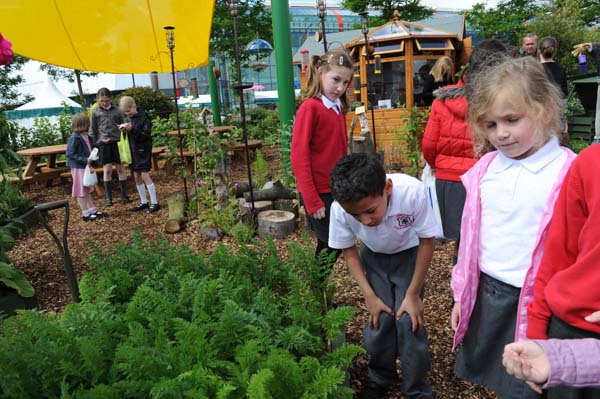
Our first school visit and we can finally see just how well the garden will accommodate 20 or 30 children. Purple carrots are just unbelievable !
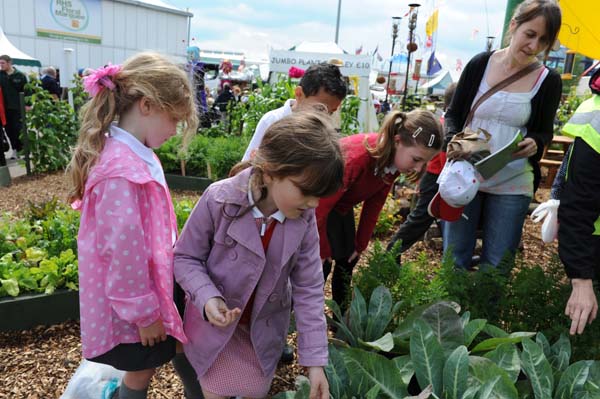
As are those different-coloured cauliflowers !
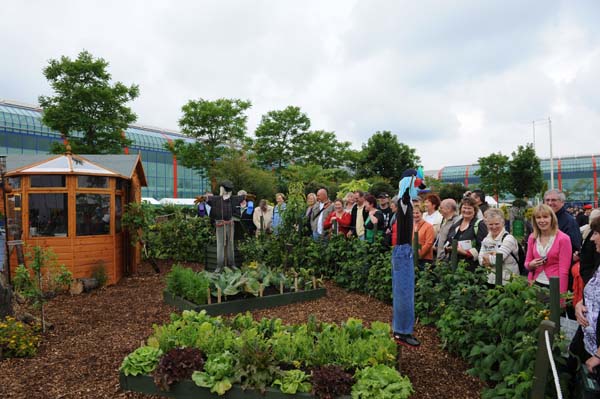
But its not only the children who show a keen interest in the garden.
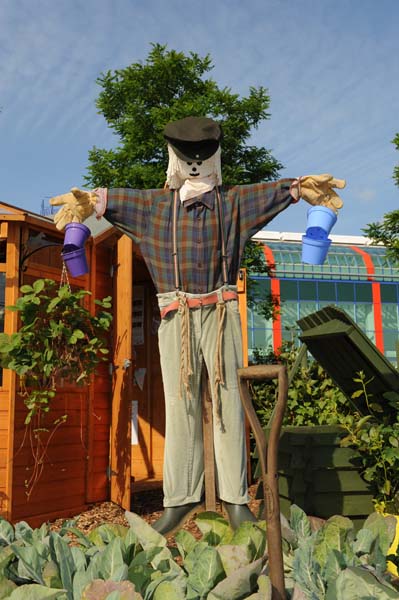
Father Scarecrow; the children of Leys farm school made a family of scarecrows for the garden and the job of keeping an eye on the brassicas went to Dad.
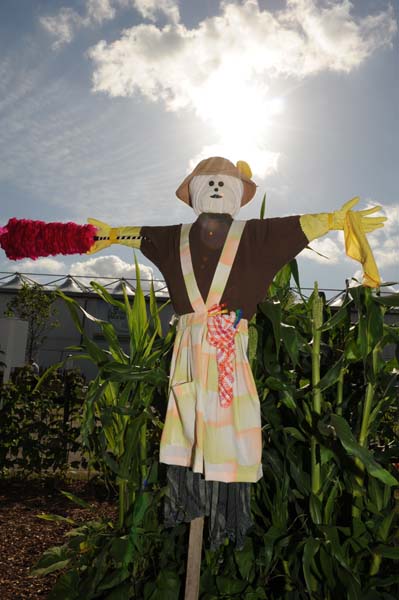
Mum looked after the three sisters (somewhat appropriately).
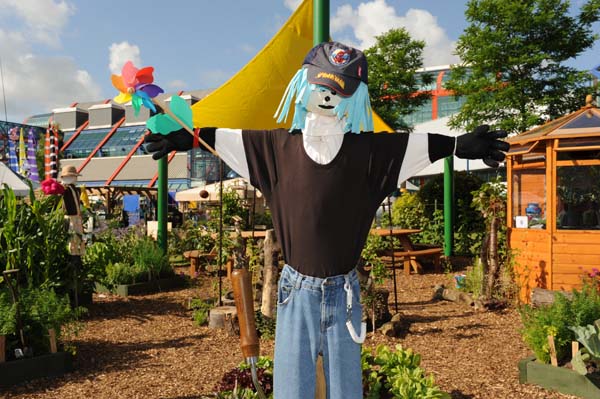
Whilst son looked after the leaf bed
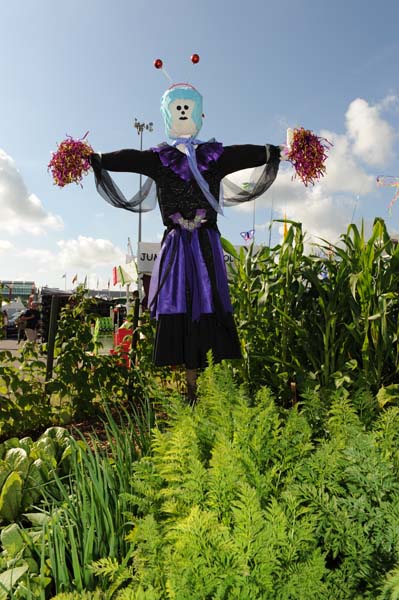
And daughter the carrots, lettuce and onions. Admired by every visitor to the garden we wonder if these are the most photographed scarecrows ever.

Shortly before closing time on the last day. John (right) and Stephen happy with a job well done - and still talking to each other !
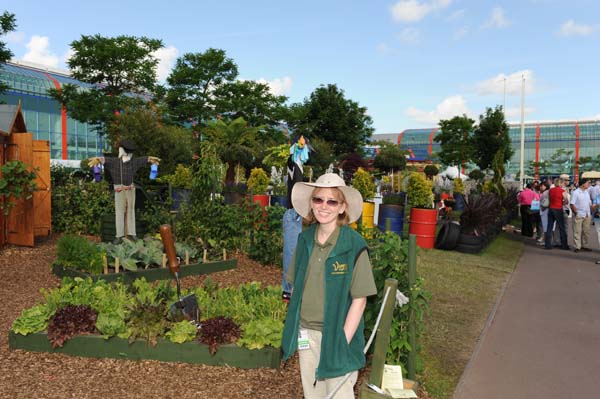
Serena also starts to wind down as, in the background, the other show gardens start to be broken down and sold off - or worse.
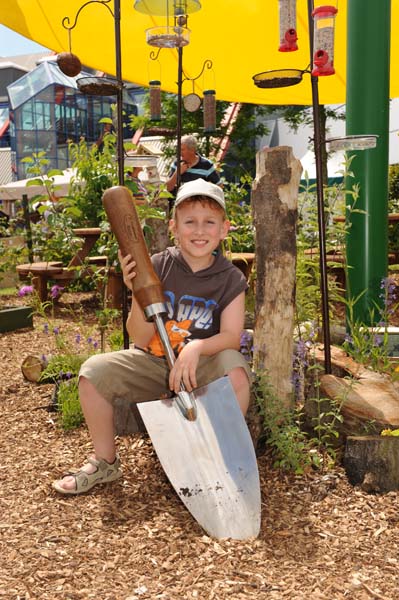
But not this garden! On the Sunday of the show 9½ year old Callum Pirie came and inspected the garden which he will have responsibility for, as Head Gardener at Leys Farm School.
Results